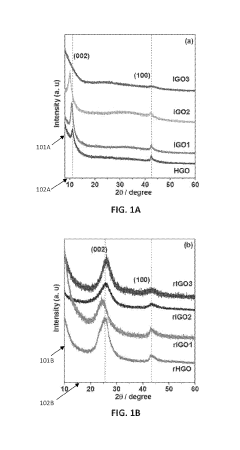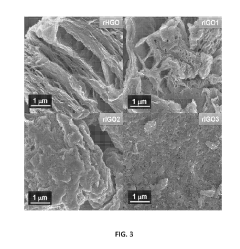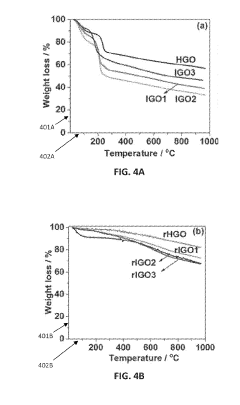Understand Graphene Oxide for Next-Gen Energy Storage
Graphene Oxide Evolution and Research Objectives
Graphene oxide has emerged as a revolutionary material in the field of energy storage, marking a significant milestone in the evolution of advanced materials. Since its discovery in 2004, graphene oxide has captivated researchers and industry experts alike due to its exceptional properties and potential applications. The journey of graphene oxide began with the groundbreaking work on graphene by Andre Geim and Konstantin Novoselov, which earned them the Nobel Prize in Physics in 2010.
The development of graphene oxide has been driven by the increasing demand for more efficient and sustainable energy storage solutions. As global energy consumption continues to rise, there is a pressing need for advanced materials that can enhance the performance of batteries, supercapacitors, and other energy storage devices. Graphene oxide, with its unique structure and properties, has shown great promise in addressing these challenges.
The evolution of graphene oxide research has been characterized by rapid advancements in synthesis methods, property characterization, and application development. Initially, the focus was on understanding the fundamental properties of graphene oxide and developing reliable production techniques. As research progressed, attention shifted towards exploring its potential in various applications, with energy storage emerging as a key area of interest.
In recent years, the research objectives for graphene oxide in energy storage have become more focused and ambitious. Scientists and engineers are now working towards harnessing the material's high surface area, excellent electrical conductivity, and mechanical strength to create next-generation energy storage devices. The primary goals include improving energy density, enhancing charge-discharge rates, and increasing the overall efficiency and lifespan of energy storage systems.
One of the key research objectives is to optimize the synthesis and functionalization of graphene oxide for specific energy storage applications. This involves developing precise control over the oxidation level, defect density, and surface chemistry of graphene oxide to tailor its properties for different types of batteries and supercapacitors. Researchers are also exploring hybrid materials that combine graphene oxide with other advanced materials to create synergistic effects and overcome existing limitations.
Another important focus is on scaling up the production of high-quality graphene oxide to meet industrial demands. This includes developing cost-effective and environmentally friendly manufacturing processes that can produce large quantities of graphene oxide without compromising its unique properties. Additionally, researchers are working on improving the integration of graphene oxide into existing energy storage technologies, addressing challenges related to material compatibility and long-term stability.
As we look towards the future, the research objectives for graphene oxide in energy storage are likely to expand further. There is growing interest in exploring its potential in emerging technologies such as flexible and wearable energy storage devices, as well as in advanced grid-scale energy storage systems. The ultimate goal is to leverage the extraordinary properties of graphene oxide to create a new generation of energy storage solutions that are more efficient, durable, and sustainable than current technologies.
Energy Storage Market Demand Analysis
The energy storage market is experiencing unprecedented growth, driven by the increasing demand for renewable energy integration, electric vehicles, and grid stability. As the world transitions towards cleaner energy sources, the need for efficient and high-capacity energy storage solutions has become paramount. The global energy storage market is projected to reach significant milestones in the coming years, with a compound annual growth rate (CAGR) exceeding industry expectations.
Lithium-ion batteries currently dominate the energy storage landscape, but there is a growing demand for alternative technologies that can offer higher energy density, longer cycle life, and improved safety. This is where graphene oxide, a derivative of graphene, shows immense potential. The unique properties of graphene oxide, including its high surface area, excellent conductivity, and mechanical strength, make it an attractive material for next-generation energy storage devices.
In the electric vehicle sector, the demand for energy storage solutions is particularly robust. Automakers are constantly seeking ways to extend the range of electric vehicles while reducing charging times. Graphene oxide-based energy storage systems could potentially address these challenges by offering higher energy density and faster charging capabilities. This aligns with the industry's push towards more efficient and consumer-friendly electric vehicles.
The renewable energy sector is another key driver of the energy storage market. As solar and wind power generation continues to grow, the need for large-scale energy storage systems to balance supply and demand becomes critical. Graphene oxide-based technologies could play a crucial role in developing grid-scale storage solutions that are more efficient and have a longer lifespan than current alternatives.
Industrial and commercial applications are also contributing to the growing demand for advanced energy storage solutions. Businesses are increasingly looking to reduce their carbon footprint and energy costs by implementing on-site energy storage systems. Graphene oxide-based technologies could offer more compact and efficient solutions for these applications, potentially revolutionizing how businesses manage their energy consumption.
The consumer electronics market represents another significant opportunity for graphene oxide-based energy storage. With the ever-increasing power demands of smartphones, laptops, and wearable devices, there is a constant need for batteries that can store more energy in smaller form factors. Graphene oxide's properties could lead to the development of batteries that not only last longer but also charge faster, addressing key consumer pain points.
As research and development in graphene oxide for energy storage progresses, the market is likely to see a surge in demand for this technology. However, challenges such as scalability and cost-effectiveness need to be addressed before widespread adoption can occur. Nevertheless, the potential benefits of graphene oxide in energy storage applications are driving significant investment and interest from both established players and startups in the energy sector.
Graphene Oxide Synthesis Challenges
The synthesis of graphene oxide (GO) presents several significant challenges that researchers and manufacturers must overcome to realize its full potential in next-generation energy storage applications. One of the primary obstacles is achieving consistent quality and uniformity in large-scale production. The Hummers method, widely used for GO synthesis, often results in variations in oxidation levels and defect densities, which can significantly impact the material's properties and performance in energy storage devices.
Another major challenge lies in controlling the degree of oxidation during the synthesis process. Over-oxidation can lead to structural damage and reduced conductivity, while under-oxidation may result in insufficient functionalization for certain applications. Striking the right balance is crucial for optimizing GO's properties for specific energy storage requirements, such as high surface area, good electrical conductivity, and appropriate pore structure.
The use of strong oxidizing agents and acids in traditional GO synthesis methods poses environmental and safety concerns. These harsh chemicals not only present handling risks but also generate hazardous waste, making the process less sustainable and potentially costly at industrial scales. Developing greener synthesis routes that maintain or improve GO quality while reducing environmental impact remains a significant challenge.
Scalability is another critical issue in GO synthesis. While laboratory-scale production can yield high-quality GO, translating these processes to industrial scales often results in compromised quality or increased costs. Maintaining consistent properties across large batches and developing continuous production methods are essential for commercial viability but present considerable technical hurdles.
The removal of synthesis byproducts and impurities from GO is also challenging. Residual metal ions, oxidizing agents, and other contaminants can significantly affect GO's performance in energy storage applications. Developing efficient purification techniques that do not compromise the material's structure or properties is crucial for producing high-quality GO suitable for advanced energy storage devices.
Lastly, the reduction of GO to reduced graphene oxide (rGO) or graphene-like materials presents its own set of challenges. Achieving complete reduction without introducing new defects or restacking of graphene sheets is difficult but necessary for many energy storage applications that require high electrical conductivity and surface area.
Current Graphene Oxide Energy Storage Solutions
01 Graphene oxide-based supercapacitors
Graphene oxide is utilized in the development of high-performance supercapacitors due to its large surface area and excellent electrical conductivity. These supercapacitors exhibit enhanced energy storage capacity and rapid charge-discharge capabilities, making them suitable for various energy storage applications.- Graphene oxide-based supercapacitors: Graphene oxide is used in supercapacitors to enhance energy storage capacity. Its high surface area and excellent electrical properties make it an ideal material for supercapacitor electrodes. The incorporation of graphene oxide in supercapacitors leads to improved energy density and power density.
- Graphene oxide-based lithium-ion batteries: Graphene oxide is utilized in lithium-ion batteries to increase energy storage capacity. It can be used as an anode material or as a conductive additive in cathodes. The high surface area and conductivity of graphene oxide contribute to improved battery performance, including higher capacity and faster charging rates.
- Functionalized graphene oxide for energy storage: Functionalization of graphene oxide can further enhance its energy storage capabilities. Various chemical modifications or doping techniques are employed to tailor the properties of graphene oxide for specific energy storage applications. This approach can lead to improved capacity, cycling stability, and overall performance of energy storage devices.
- Graphene oxide composites for energy storage: Composites of graphene oxide with other materials are developed to enhance energy storage capacity. These composites can combine the advantages of graphene oxide with those of other materials, such as metal oxides or conductive polymers. The resulting hybrid materials often exhibit synergistic effects, leading to improved energy storage performance.
- Graphene oxide-based flexible energy storage devices: Graphene oxide is utilized in the development of flexible and wearable energy storage devices. Its mechanical properties and ability to be processed into thin films make it suitable for flexible electrodes. These devices can maintain high energy storage capacity while being bendable and stretchable, opening up new applications in wearable electronics and flexible devices.
02 Graphene oxide-based lithium-ion batteries
Graphene oxide is incorporated into lithium-ion battery electrodes to improve their energy storage capacity and overall performance. The material's unique properties allow for better lithium-ion intercalation and enhanced electron transport, resulting in higher energy density and longer battery life.Expand Specific Solutions03 Functionalized graphene oxide for energy storage
Graphene oxide is functionalized with various chemical groups or nanoparticles to enhance its energy storage capabilities. These modifications can improve the material's electrochemical properties, increase its specific capacitance, and optimize its performance in energy storage devices.Expand Specific Solutions04 Graphene oxide-based composite materials for energy storage
Composite materials incorporating graphene oxide are developed to enhance energy storage capacity. These composites combine the advantages of graphene oxide with other materials, such as metal oxides or conductive polymers, to create synergistic effects and improve overall energy storage performance.Expand Specific Solutions05 Graphene oxide-based flexible energy storage devices
Flexible energy storage devices utilizing graphene oxide are developed for wearable and portable electronics. These devices leverage the material's mechanical flexibility and high energy storage capacity to create bendable, stretchable, or foldable energy storage solutions with improved performance and durability.Expand Specific Solutions
Key Players in Graphene Oxide Research
The graphene oxide market for next-generation energy storage is in a rapid growth phase, driven by increasing demand for high-performance energy storage solutions. The market size is expanding significantly, with projections indicating substantial growth in the coming years. Technologically, graphene oxide is advancing quickly, with various maturity levels across applications. Leading institutions like Lawrence Livermore National Security LLC, Semiconductor Energy Laboratory Co., Ltd., and Zhejiang Sci-Tech University are at the forefront of research and development. Universities such as Fudan University and King Abdullah University of Science & Technology are contributing to fundamental advancements, while companies like SABIC Global Technologies BV and Nanotek Instruments, Inc. are focusing on commercial applications. The competitive landscape is diverse, with a mix of academic institutions, national laboratories, and private companies driving innovation in this promising field.
Semiconductor Energy Laboratory Co., Ltd.
King Abdullah University of Science & Technology
Breakthrough Patents in Graphene Oxide Technology
- Coating graphene oxide on the zinc anode to enhance electrical conductivity and reduce zinc ion dissociation into the electrolytic solution, thereby minimizing electronic impedance and improving the battery's performance.
- A method involving the oxidation of graphite in a mixture of phosphoric and sulfuric acids with KMnO4, followed by dispersion in water and adjustment of pH, results in high-purity graphene oxide with improved capacitance and reduced impurities, which can be further reduced to produce reduced graphene oxide with enhanced specific capacitance.
Environmental Impact of Graphene Oxide Production
The production of graphene oxide, while promising for next-generation energy storage applications, raises significant environmental concerns that warrant careful consideration. The synthesis process typically involves the oxidation of graphite using strong oxidizing agents, such as potassium permanganate and sulfuric acid, which can lead to the generation of hazardous waste and potentially harmful byproducts.
One of the primary environmental impacts is the release of toxic chemicals during the production process. The use of strong acids and oxidants can result in the emission of volatile organic compounds (VOCs) and other air pollutants if not properly controlled. These emissions may contribute to air quality degradation and pose health risks to workers and nearby communities if adequate safety measures are not implemented.
Water pollution is another critical concern associated with graphene oxide production. The process often requires large volumes of water for washing and purification steps, potentially leading to the discharge of contaminated wastewater containing residual chemicals and nanomaterials. If not properly treated, this wastewater can harm aquatic ecosystems and potentially enter the food chain.
The disposal of solid waste generated during graphene oxide production also presents environmental challenges. Residual materials, including unreacted graphite and chemical byproducts, require proper handling and disposal to prevent soil contamination and potential groundwater pollution. The long-term environmental fate of graphene oxide nanoparticles themselves is not yet fully understood, raising concerns about their potential accumulation in the environment and impact on ecosystems.
Energy consumption is another significant factor to consider. The production of graphene oxide can be energy-intensive, particularly during the oxidation and exfoliation processes. This high energy demand may contribute to increased greenhouse gas emissions if the energy source is not renewable, potentially exacerbating climate change concerns.
To address these environmental impacts, researchers and manufacturers are exploring more sustainable production methods. Green synthesis approaches, such as electrochemical exfoliation and the use of bio-based reducing agents, are being investigated to minimize the use of harsh chemicals and reduce waste generation. Additionally, efforts are being made to develop closed-loop systems that recycle and reuse chemicals and water, thereby reducing the overall environmental footprint of graphene oxide production.
As the demand for graphene oxide in energy storage applications grows, it is crucial to balance the potential benefits with the environmental costs. Implementing stringent environmental management practices, investing in cleaner production technologies, and conducting comprehensive life cycle assessments will be essential to ensure the sustainable development of this promising material for next-generation energy storage solutions.
Scalability and Commercialization Prospects
The scalability and commercialization prospects for graphene oxide in next-generation energy storage are promising, yet face several challenges. The production of high-quality graphene oxide at industrial scales remains a significant hurdle. Current methods, such as the modified Hummers' method, are limited in their ability to produce large quantities of consistent, high-quality material. This bottleneck has implications for the widespread adoption of graphene oxide in energy storage applications.
Despite these challenges, advancements in production techniques are being made. Researchers are exploring continuous flow processes and environmentally friendly synthesis methods that could potentially increase production capacity while reducing costs. These developments are crucial for meeting the growing demand for graphene oxide in the energy storage sector.
The commercialization of graphene oxide-based energy storage devices is gaining momentum. Several companies are investing in pilot production lines and scaling up their manufacturing capabilities. This trend is particularly evident in the development of supercapacitors and high-performance batteries, where graphene oxide's unique properties offer significant advantages over traditional materials.
Market analysts predict a substantial growth in the graphene oxide market, driven largely by its applications in energy storage. The increasing focus on renewable energy and electric vehicles is expected to further boost demand. However, the success of commercialization efforts will depend on achieving cost-competitiveness with existing technologies.
Regulatory considerations also play a role in the scalability and commercialization of graphene oxide. As a relatively new material, safety assessments and environmental impact studies are ongoing. The outcomes of these studies will influence the regulatory landscape and, consequently, the ease of commercialization.
Collaboration between academia and industry is accelerating the transition from lab-scale discoveries to commercial products. Joint research initiatives and technology transfer programs are helping to bridge the gap between fundamental research and practical applications. This synergy is crucial for overcoming technical challenges and developing scalable production processes.
In conclusion, while the path to large-scale commercialization of graphene oxide in energy storage applications is not without obstacles, the potential benefits continue to drive innovation and investment in this field. As production techniques improve and costs decrease, graphene oxide is poised to play a significant role in shaping the future of energy storage technologies.



